| EENS 2120 |
Petrology |
| Prof. Stephen A. Nelson |
Tulane University |
|
Metamorphic Rock Textures |
|
| Metamorphic rocks exhibit a variety of textures. These can range from textures
similar to the original protolith at low grades of metamorphism, to textures that are
purely produced during metamorphism and leave the rock with little resemblance to the
original protolith. Textural features of metamorphic rocks have been discussed in
the previous lecture. Here, we concentrate on the development of foliation, one of
the most common purely metamorphic textures, and on the processes involved in
forming compositional layering commonly observed in metamorphic rocks.
Foliation
|
| Stress and Preferred Orientation Pressure increases with depth of burial, thus, both pressure and temperature will vary with depth in the Earth. Pressure is defined as a force acting equally from all directions. It is a type of stress, called hydrostatic stress or uniform stress. If the stress is not equal from all directions, then the stress is called a differential stress. Normally geologists talk about stress as compressional stress. Thus, if a differential stress is acting on the rock, the direction along which the maximum principal stress acts is called σ1, the minimum principal stress is called σ3, and the intermediate principal stress direction is called σ2. Note that extensional stress would act along the direction of minimum principal stress. |
|
If differential stress is present during metamorphism, it can have a
profound effect on the texture of the rock.
|
 |
|
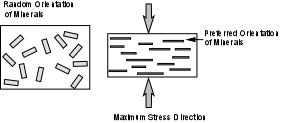 |
This is because growth of such minerals is easier along directions parallel to sheets, or along the direction of elongation and thus will grow along σ3 or σ2, perpendicular to σ1. Since most phyllosilicates are aluminous minerals, aluminous (pelitic) rocks like shales, generally develop a foliation as the result of metamorphism in a differential stress field.
|
Shales have fissility that is caused by the preferred orientation of clay minerals with their {001} planes orientated parallel to bedding. Metamorphic petrologists and structural geologists refer to the original bedding surface as S0. |
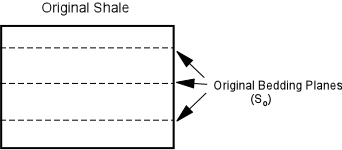 |
|
Note that in the case shown here, the maximum principle stress is oriented at an angle to the original bedding planes so that the slatey cleavage develops at an angle to the original bedding. The foliation or surface produced by this deformation is referred to S1. |
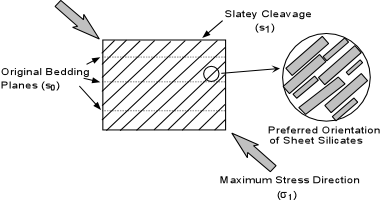 |
|
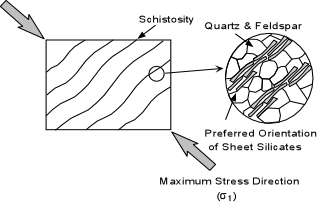 |
|
These dark colored minerals tend to become segregated into distinct bands through the rock (this process is called metamorphic differentiation), giving the rock a gneissic banding. Because the dark colored minerals tend to form elongated crystals, rather than sheet- like crystals, they still have a preferred orientation with their long directions perpendicular to the maximum differential stress. |
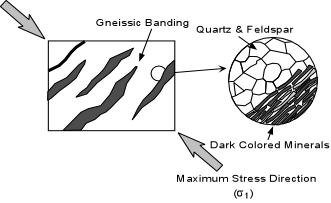 |
|
 |
In general, the grain size of metamorphic rocks tends to increase with increasing grade of metamorphism, as seen in the progression form fine grained shales to coarser (but still fine) grained slates, to coarser grained schists and gneisses. Metamorphism and Deformation Most regionally metamorphosed rocks (at least those that eventually get exposed at the Earth's surface) are metamorphosed during deformational events. Since deformation involves the application of differential stress, the textures that develop in metamorphic rocks reflect the mode of deformation, and foliations or slatey cleavage that develop during metamorphism reflect the deformational mode and are part of the deformational structures. |
| The deformation involved in the formation of fold-thrust mountain belts generally involves compressional stresses. The result of compressional stress acting on rocks that behave in a ductile manner (ductile behavior is favored by higher temperature, higher confining stress [pressure] and low strain rates) is the folding of rocks. Original bedding is folded into a series of anticlines and synclines with fold axes perpendicular to the direction of maximum compressional stress. These folds can vary in their scale from centimeters to several kilometers between hinges. Note that since the axial planes are oriented perpendicular to the maximum compressional stress direction, slatey cleavage or foliation should also develop along these directions. Thus, slatey cleavage or foliation is often seen to be parallel to the axial planes of folds, and is sometimes referred to axial plane cleavage or foliation. | 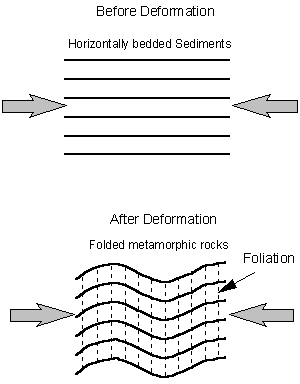 |
Metamorphic Differentiation As discussed above, gneisses, and to some extent schists, show compositional banding or layering, usually evident as alternating somewhat discontinuous bands or layers of dark colored ferromagnesian minerals and lighter colored quartzo-feldspathic layers. The development of such compositional layering or banding is referred to as metamorphic differentiation. Throughout the history of metamorphic petrology, several mechanisms have been proposed to explain metamorphic differentiation. |
|
In such a case, a foliation might develop in the shale layers due to the recrystallization of clay minerals or the crystallization of other sheet silicates with a preferred orientation controlled by the maximum stress direction. |
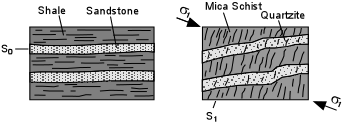 |
Here, it would be easy to determine that the compositional layers represented original bedding because the foliation would cut across the compositional layering. |
In highly deformed rocks that have undergone both folding and shearing, it may be more difficult to determine that the compositional layering represents original bedding. As shearing stretches the bedding, individual folded beds may be stretched out and broken to that the original folds are not easily seen. |
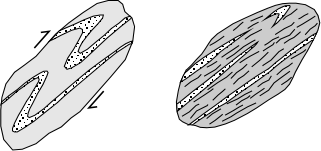 |
Similarly, if the rock had been injected by dikes or sills prior to metamorphism, these contrasting compositional bands, not necessarily parallel to the original bedding, could be preserved in the metamorphic rock.
|
|
|
|
|
Thus felsic minerals could be dissolved from one part of the rock and preferentially nucleate and grow in another part of the rock to produce discontinuous layers of alternating mafic and felsic compositions. |
 |
|
Examples of questions on this material that could be asked on an exam
|